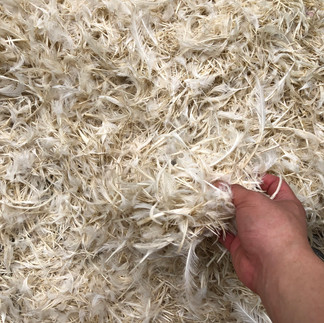The latest news, trends, analysis, interviews and podcasts from the global food and beverage industry
It’s easy to get swept up in the news and activities of the industry’s global titans, but what about the smaller firms that are out there flexing their creative muscles? In this instalment of ‘Start-up of the month’ – which celebrates the lesser-known companies and their innovations – we speak to Sorawut Kittibanthorn (pictured) and Tom Washington, co-founders of Kera Protein, a company creating edible protein from chicken feathers.

Can you share the journey that led to the creation of Kera Protein and the inspiration behind using chicken feathers as a protein source?
Kera’s journey began as a student project at Central Saint Martins in 2019, driven by a commitment to innovation in waste management. Over several years, its founder explored ways to address the global issue of chicken feather waste, noticing the lack of effective disposal methods. Instead of focusing on the feathers’ physical properties, Kera took a unique approach by examining their chemical composition, leading to groundbreaking discoveries.
Initially, Kera investigated various sources of keratin waste, even developing a method to convert keratin into bioplastic with enhanced strength. This research laid the foundation for Kera’s innovative approach to waste management.
Recognising the protein-rich potential of chicken feathers, Kera envisioned extracting a digestible form for human consumption. This breakthrough could provide a high-protein food source with antioxidant benefits comparable to strawberries.
With ambitious goals, Kera aims to shift perceptions of chicken feathers, showcasing them as a valuable resource rather than a discarded byproduct. This unique initiative focuses on achieving zero waste through chemical processing, transforming waste materials into products that meet consumer expectations. Kera’s mission is to highlight the full potential of food waste, treating it as a thoughtfully crafted resource rather than mere leftovers.
What challenges did you face while developing the recipe for 'feather meat,' and how did you overcome them?
We have been working to mimic the taste and texture of meat as closely as possible. However, to be honest, even plant-based meats that have been on the market for years—with millions of pounds invested in technology – still haven’t fully replicated real meat. At this stage, we don’t see the need to rely on advanced technology, especially as this challenge is ongoing.
Rather than positioning ourselves strictly as a 'chicken substitute' or 'meat alternative,' we’re presenting our product as a new kind of meat – but better, with a focus on sustainability and nutrition. By framing our product as something innovative, we step away from strict comparisons to traditional meat, which lowers expectations for exact replication and encourages people to experience our product on its own terms. This approach often makes it easier for people to embrace our recipe.
That said, our product still provides the meaty taste and texture people expect from meat alternatives. In taste tests, people often comment that 'everything tastes normal,' and they don’t detect any unusual flavours. Remarkably, they can’t even tell it’s made from feathers.
How do you envision Kera contributing to the zero-waste movement, and what impact do you hope it will have on consumer perceptions of food waste?
Kera will contribute the idea that eating waste is posh. We challenge the stigma surrounding chicken feathers (waste) by introducing an innovative approach to the zero-waste movement. We are highlighting the nutritional value of this waste, particularly its chemical properties.
We emphasise that innovation and aesthetics can upcycle waste into something unconventional yet brilliant. We hope this introduction conveys the message that value should be seen from within, as we bring the inside out. Don’t judge its value by how it’s been treated – by being innovative and creative, we can make use of things that support others.
What steps are you taking to ensure that Kera's products align with sustainability and ethical sourcing practices?
First of all, as simply as we collect waste from the farm, this already contributes to sustainable practices. We recognise that this waste would otherwise end up in landfills or incineration. By repurposing it, we’re already making a positive impact.
Secondly, our extraction process is specifically designed with sustainability in mind. We use a biological extraction method, which minimises the use of harmful chemicals that can negatively affect the environment. While physical extraction processes often require a lot of energy to achieve the same result, we chose a more time-intensive approach that’s ultimately better for the environment. This way, we avoid creating issues that would require more resources to fix later.
Finally, regarding its application, some argue that vegan or vegetarian diets rely heavily on monoculture farming. However, this protein aligns well with a flexitarian approach, as we utilise byproducts that are already available, without needing to create something entirely new on the producer’s end.
Can you describe the nutritional benefits of feather meat compared to traditional protein sources?
Kera products contain a protein ratio similar to that of chicken breast, with amino acids derived from chicken feathers that support muscle mass gain. Research also indicates that keratin protein has a high antioxidant content, comparable to that of berries. These are key strengths of Kera products.

Your project gained significant media attention. How has this influenced your strategy for launching Kera in the market?
This is a good marketing tool for us to use, as we need to raise people’s awareness and educate them that chicken feathers are now valuable and could be another source of protein for humans. We always refer to media outlets to help customers trust our business, as it may seem a bit unusual, and people might be resistant at first. However, since we refer to these sources, it becomes easier for us to break the initial impression and encourage people to try it, which is always the most difficult step.
What advice would you offer to other start-ups in the food and beverage space looking to innovate with unconventional ingredients?
Identify a unique approach for your business. While it may feel risky and even isolating to take an unconventional path, taking risks during the ideation stage can set you apart and earn valuable recognition. Aim big – finding a 'wow' factor is key to developing a standout product.
How do you plan to educate consumers about the benefits of consuming edible feathers and overcome any neophobia associated with novel foods?
This is a good marketing tool for us to use, as we need to raise people’s awareness and educate them that chicken feathers are now valuable and could be another source of protein for humans. We always refer to media outlets to help customers trust our business, as it may seem a bit unusual, and people might be resistant at first. However, since we refer to these sources, it becomes easier for us to break the initial impression and encourage people to try it, which is always the most difficult step.

What role do you believe social influence plays in shaping a new food culture around sustainable practices, and how does Kera aim to tap into this?
Social influence can significantly affect levels of neophobia. Looking back, some food sources that were once considered low-grade, such as lobster in the US, or even prohibited, like beef in some Chinese cultures due to cultural beliefs around selfishness, eventually became widely accepted. These cases demonstrate that societal views can shift greatly under social influence, and we believe similar change is possible.
We envision Kera as a model that promotes a new perspective on food consumption – one that encourages bravery and adaptation toward a sustainable future. Our goal is to challenge old stigmas and share the belief that this food is derived from the same resources we already rely on, simply utilising different parts to reduce waste and increase sustainability.
Looking ahead, what are your aspirations for Kera Protein, and how do you see it evolving in the next five years?
We want to emphasise that Kera’s main vision is to reduce waste in the poultry industry. Changing perceptions may take time, but this focus on waste reduction sets us apart and has earned us recognition. However, waste is a daily issue that requires immediate solutions. Our current applications are effective, whether repurposing waste into animal feed or transforming farmers’ expenses into something more valuable to support a circular economy.
#KeraProtein #startuponthemonth #startup #meatalternatives



















